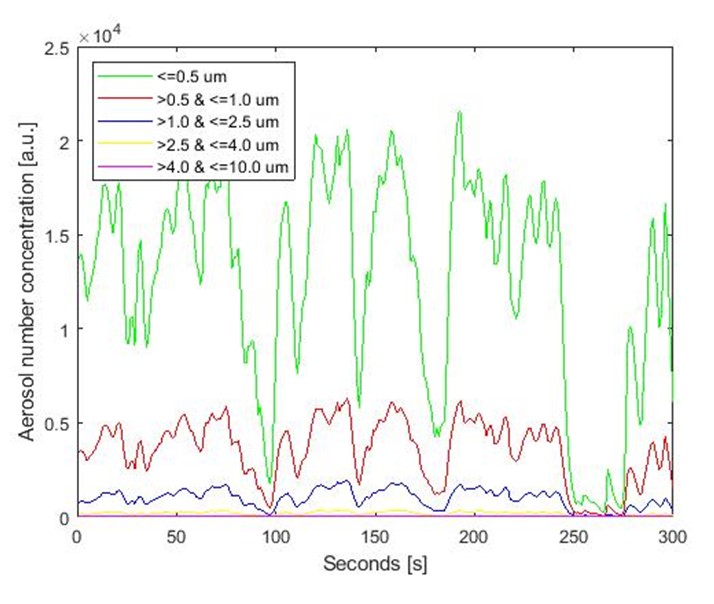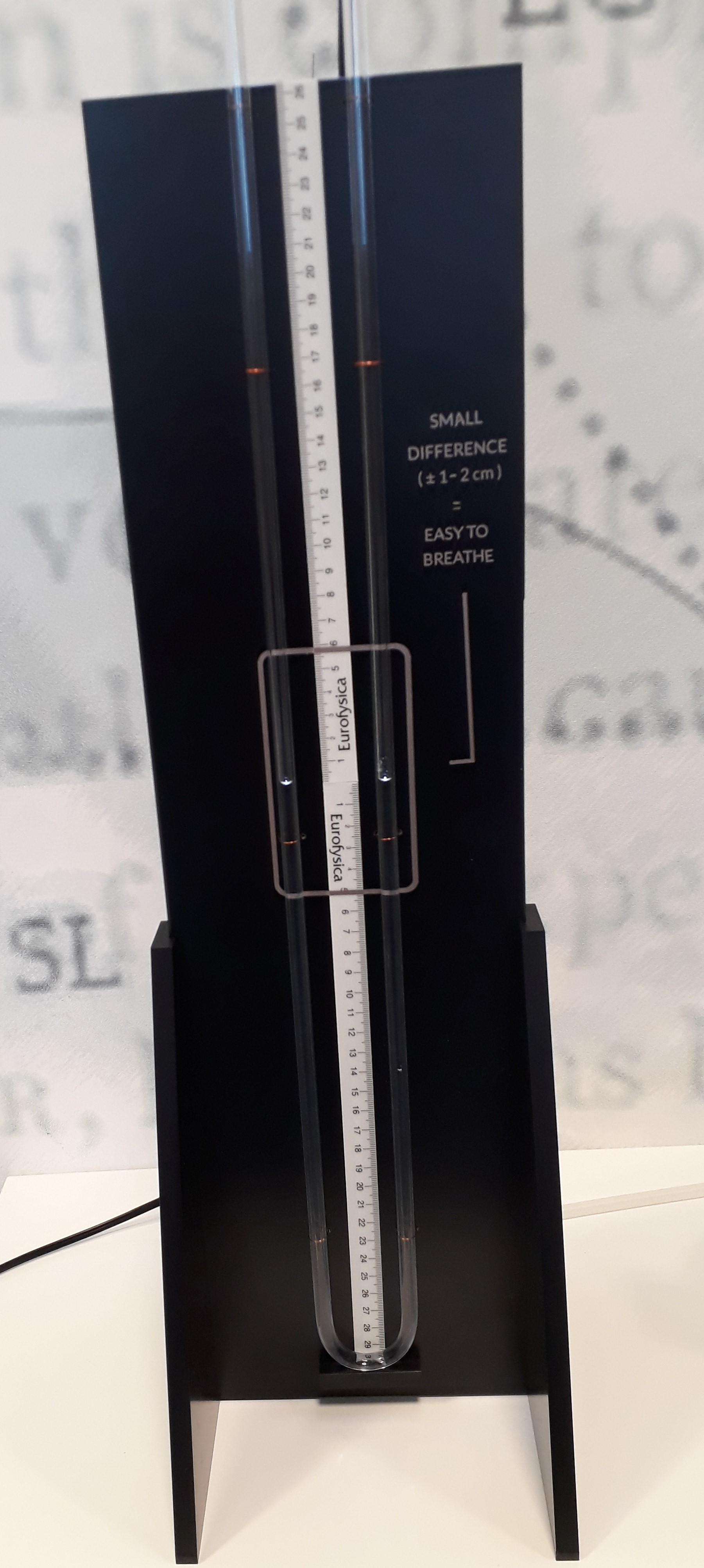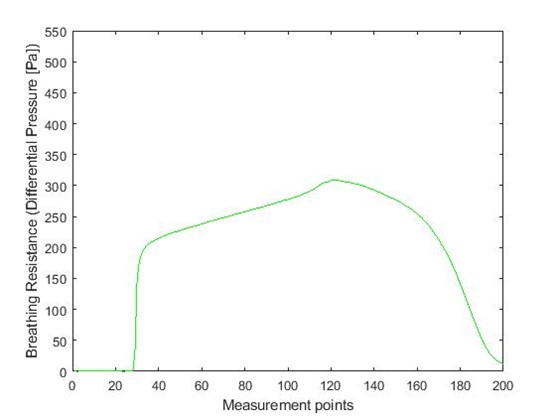Face mask testing TU/e
Towards an open source face mask test
TECHNICAL DETAILS
All information is open source and free for you to use
For specific questions contact Kevin Vos: k.g.m.vos@student.tue.nl
JUMP TO:
Basis setup Aerosol filtering test Breathing Resistance test
___________________________________________________
The basic setup used can be easily build using DIY materials and a 3D printer. The complete guide with CAD design can be found here:
How to build a breathing resistance test (TU-Delft)
Fan used:
Sanyo Denki San Ace fan:
Price: €31,97 (RS components)
- Model: 9BMB24P2H01
- Rated voltage: 24 V
- Rated current: 0.55 A
- Operating temperature: -20 to +70 °C
- Mass: 190 g
- Operating voltage range: 21.6 ~ 26.4 V
- Rated input: 13.2 W
- Max airflow: 1.11 m3/min
- SPL: 57 dB(A)
AEROSOL FILTERING TEST
A picture of the set up for measuring the particle filtering efficiency. Here us is made of a consumer nebuliser for generating an aerosol stream, whereas an industrial particulate matter sensor is used for determining the particle penetration
AEROSOL GENERATOR
Using a standard consumer Philips nebuliser, an aerosol stream is generated (Price ~60 Euro). A nebuliser normally used for changing medication from a liquid to a mist so that it can be more easily inhaled into the lungs. In order to generate an aerosol one should make use of a 1% NaCl solution. Using a fan the aerosol stream is sucked through the face mask. The volumetric flow rate is in the order of: 735 L/min
A picture clearly showing the aerosol being generated and sucked through the face mask
Philips InnoSpire Elegance Humidifier:
Price: €59,99
- Weight: 1.5 kg
- Supply voltage: 230 V
- Maximum flow rate: 9.4 lpm
- Maximum pressure: 44 psi
- Average flow rate: 7 lpm @ 10 psi
- Size: 165x165x108 mm
- Noise level: 58 ± 3 dBA
- Median mass aerodynamic diameter (MMAD): 2.9 µm
- Fine particle fraction (FPF): 77% below 5 µm
- Nebulization capacity: 8 ml
PARTICULAR MATTER SENSOR
To measure the aerosols, a Sensirion SPS30 Particulate Matter Sensor is used, which has a lower limit of 0.3 um and an upper limit of 10um. The sensor thus has a particle detection size range between 0.3 um and 10 um. The sensor measures the number concentration of the particle size and puts them in five different size categories. These five categories are: PM0.5, PM1.0, PM2.5, PM4.0 and PM10.0. PMx defines particles with a size smaller than x micrometers, hence PM0.5 indicates particles from 0.3 um to 0.5 um while PM10.0 indicates particles from 0.3 um to 10.0 um. The sensor has a minimum sampling interval of 1 s. Its operating temperature ranges from -10 degree C to +60 degree C, while the storing temperature of the sensor ranges between -40 degrees C and +70 degrees C. Since both testing and storing of the sensor are performed at normal room temperature it is assumed that the sensor performs well.
Sensirion SPS30 Particulate Matter Sensor:
Price: €44,95 (RS components)
- Particle detection size range:
- number concentration (range 0 to 3000 in 1/cm3): PM0.5, PM1.0, PM2.5, PM4 & PM10
- Lower limit of detection: 0.3 µm
- Minimum sampling interval: 1 sec
- Dimensions: 40.6 x 40.6 x 12.2 mm¬3
- Operating temperature range: -10 to +60 °C
- Storage temperature range: -40 to +70 °C
- Supply voltage: 4.5 – 5.5 V
SOFTWARE
In order to read out the particulate matter sensor we make use of an Arduino. The software for this sensor is open source and can be found here
MEASUREMENT
The result of a measurement over 5 minutes in given in the figure
Figure showing the aerosol concentration over time for various classes of particles
As can be seen the data in the figure show a fluctuating behavior. Hence we have chosen to take the mean over five minutes. This mean value of a face mask is divided by the mean value of the calibration measurements, which results in a number between 0 and 1. Here we have taken as a calibration the situation without a mask. This number gives an indication how well the mask is performing in filtering aerosols, ranging from 0 indicating no particles penetrating and 1 indicating all particles penetrating. Since it was found very early on in this study that the larger than 0.5 um size categories displayed lower numbers when the mean values were divided, this led to the simplification to only look at 0.3 um to 0.5 um size range of particles in the remainder of the study. This poses an upper limit on the number between 0 and 1, i.e. for size categories larger than 0.5 um this number between 0 and 1 will always be lower than for the smallest size category. It was found in various measurements that using this detector one can observe larger particles (droplets) being broken up in smaller ones.
BREATHING RESISTANCE
In this test we determine the breathing resistance of a mask by measuring the pressure difference of a face mask as generated during a flow. In order to generate the flow we make use of standard low-cost pressure generator. Using a low-cost differential pressure sensor we measure the pressure difference. In order to compare the various masks we compare the resistance to a standard medical face mask.
A picture of the set up for measuring the breathing resistance. Here us is made of a consumer compressor to generator to generate an airflow. Using a differential pressure sensor the pressure drop is measured of the face mask, which is a measure for the breathing resistance.
PRESSURE DIFFERENCE MEASUREMENT
The Sensirion SDP810 500Pa Digital Differential Pressure Sensor is used to measure the differential pressure. It has a measurement range between -500 Pa and +500 Pa. Since the compressor can create pressures higher than +500 Pa, the compressor is tuned at 0.5 atmosphere. This ensures that the upper limit of the sensor is not reached during testing, while the sensor still gives a good range of results for different face masks. The operating and storage temperature of the sensor ranges from -40 degrees C to +85 degrees C. As mentioned earlier, the testing and storing of the sensors are performed at normal room temperature, hence it is assumed that the sensor performs well.The volumetric flow rate reached is in the order of 72 L/min (1.2 L/s)
SOFTWARE
In order to read out the pressure sensor we make use of an Arduino. The software for this sensor is open source and can be found here
Sensirion SDP 810 500Pa Digital Differential Pressure Sensor:
Price: €30,61 (RS components)
- Measurement range: -500 to 500 Pa
- Calibrated for: Air, N2
- Media compatibility: Air, N2, O2, non-condensing
- Supply Voltage: min = 2.7 V, max = 5.5 V
- Absolute supply voltage: -0.3 to 5.5 V
- Operating temperature range (air): -40 to 85 °C
- Storage temperature range: -40 to 85 °C
Aerotec Airliner Silent Pneumatic compressor 8 bar:
Price: €139,00 (Conrad)
- Vermogen: 370 W
- Aanzuigvermogen: 70 l/min
- Debiet: 55 l/min
- Overdruk: 8 bar
- Ketelinhoud: 6 l
- Geluidsniveau: 88 dB
alternative
Alternatively one can make of a water column for reading pressure in millimeters of water column, which can be directly converted to Pa. This gives an immediate visual result.
A water gauge pressure meter as to give a direct visual indication of the pressure difference
MEASUREMENT
Using the differential pressure sensor the pressure difference over the face mask is measured after the valve is opened of the compresser tank. Hence the pressure difference will rise up to a maximum and slowly decreases as the tank is emptied. In this figure the results of a differential pressure measurement is given.
The pressure difference as measured over a face mask as function of time, i.e., as the compressor tank is emptied
We have taken the maximum of the line as the measurement for a face mask. This maximum is divided by the limit of the pressure sensor, which is 550 Pa. This results in a number between 0 and 1, indicating the breathing resistance. The lower the number, the easier it is to breathe through the fabric, while a higher number indicates a more difficult to breathe through fabric. This is physically understood by the fact that the higher the pressure is, the more difficult it is for the air to flow through the fabric.
13-11-2020
Website disclaimer
The information contained in this website is for personal use only. While we endeavour to keep the information up to date and correct, we make no representations or warranties of any kind, express or implied, about the completeness, accuracy, reliability, suitability or availability with respect to the website or the information, products, services, or related graphics contained on the website for any purpose. Any reliance you place on such information is therefore strictly at your own risk. In no event will we be liable for any loss or damage including without limitation, indirect or consequential loss or damage, or any loss or damage whatsoever arising from loss of data or profits arising out of, or in connection with, the use of this website. Through this website you are able to link to other websites which are not under the our control and we have no control over the nature, content and availability of those sites and have no control over pop-us.





